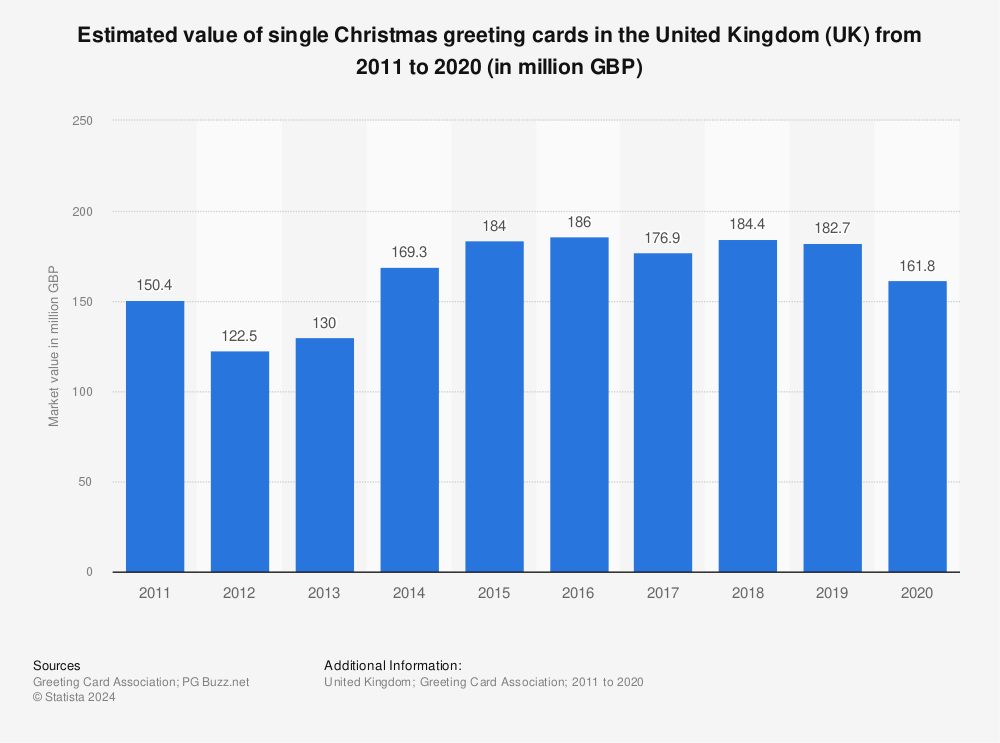
Christmas Cards Facts and Statistics (UK) - Updated 2022
Richard O'ConnorShare
If you love Christmas, and love sending and receiving Christmas Cards, then you may have wondered about how many cards are sent and when the first cards were sent. Well, now you can learn the answers to these question and many more with our Christmas Cards Facts and Statistics guide - with data based on the UK and updated in November 2022.
How many Christmas Cards are sold and sent in the UK?
It is estimated that 900 million cards are sent in the UK each year, with each person sending around 16 cards.
The value of single Christmas Cards in the UK was £161.8 million in 2020. The highest amount so far was £186 million in 2016.

Find more statistics at Statista
The Royal Mail estimates that it delivers around 150 million cards every year in the UK.
About 60% of all Greeting Card sales are Christmas Cards, with around one-third of those featuring a religious theme.
Charity Christmas Cards are also popular, raising an estimated £50 million per year for various charities across the UK.
Men purchase only 15% of all Christmas Cards sold.
Around 500 million eCards are sent at Christmas through emails, graphics and social media messages.
How Many Christmas Cards Does a Tree Make?
A single tree can produce around 3000 greeting cards, which means that a staggering 300,000 trees would need to be cut down just for the UK’s yearly Christmas Cards demand. That’s enough to cover over 1000 football pitches.
When Was the First Christmas Card Sent?
Although people have probably exchanged written greetings for many centuries, the first recorded Christmas Card was sent in 1611 by a German physician, Michael Maier, to James I of England.
Who wrote the first Christmas Cards?
Christmas cards were originally penned in England by boys who were practising their writing skills, they would present these handmade cards to their parents.
The first commercial Christmas Cards were created by Henry Cole, a prominent civil servant who later became a founder of the Victoria & Albert Museum, where the first ever card is now displayed.
Sending written greetings to friends and family at Christmas was already commonplace. But the Cole household was a popular one, resulting in many unanswered letters. Not wanting to appear rude, Cole’s idea was to use a printed card that could be sent quickly and easily to friends and family, with a printed image on one side and space for a message on the other. Henry Cole turned to his friend and artist John Callcott Horsley to create the illustration, who also became the recipient of the first card sent by Cole.
The first cards were sold in 1843 - Only 1000 were produced, costing a shilling each. Equivalent to around a day’s earnings for the average worker.

Public Domain, Link
The first folded Christmas Cards, like those we’re familiar with today, were put into circulation in the early 20th century by the Hall Brothers, who later became the Hallmark brand.
Why are Robins associated with Christmas?
In Victorian England, postmen were often referred to as Red Robins because of their red uniforms (As is still the case with Royal Mail workers today). Postmen or Red Robins would be seen more often in the run-up to Christmas, which is why Robins (the bird kind) are also associated with Christmas.
